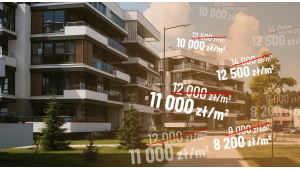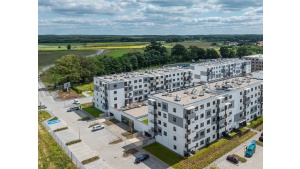Demolition or redevelopment?
Prestige PR
Włodarzewska 81C lok 81
02-393 Warszawa
i.wisniewska|prestigepr.pl| |i.wisniewska|prestigepr.pl
508 927 958
www.prestigepr.pl
Older buildings are making way for new ones, and the trend of redeveloping plots in the centers of large cities in Poland is intensifying. Furthermore, the plans include not only new development projects that arise after demolitions but also transforming existing office buildings into residential projects, including those in PRS (Private Rented Sector) formula.
The huge demand in the rental housing market in Poland, coupled with a gradual increase in rental rates amidst a significant housing shortage, is encouraging investors to undertake further projects in the PRS formula. Paradoxically, the geopolitical and macroeconomic situation, including war in Ukraine, is also conducive to the development of such investments, as it generates additional potential tenants. Above all, the Polish market still offers the opportunity to achieve higher investment returns than the Western European market.
According to Avison Young experts, the value of transactions closed in 2022 could be estimated at 150 million euros, and cumulatively from 2014, it reached 325 million euros. However, the true dynamics of the sector is reflected in volume of forward funding transactions. Only in the years 2021-2022, according to Avison Young's analysis, it amounted to 700 million euros.
Investors' announcements indicate that the plans for the upcoming years include the construction of another ~ 25,000 apartments for rent in Poland. PRS investments are mainly taking place in the largest cities in the country, with 40% of the currently active PRS stock, totaling 12,500 apartments, located in Warsaw. Over 13,000 units are currently under construction, with approximately 4,500 expected to be delivered this year. However, it is still not enough considering the demand.
Land at a premium
A serious obstacle to the development of residential investments is the shortage of available land in attractive areas of the largest Polish cities. As a result, investors are seeking alternative solutions, such as acquiring parcels with older buildings that can be adapted to new functions or demolished. The trend of real estate conversions is intensifying on the market.
The advantage of investments based on demolition or modernization of existing facilities is shorter administrative procedures, which do not require road approvals or participation in the construction of the surrounding infrastructure.
- The number of inquiries regarding analyses of the possibility of adapting existing commercial properties for new purposes is increasing. In such cases, our team evaluates, among other things, the profitability of the investment, considering options of demolishing older office buildings or transforming them into PRSs. When planning such actions, investors seek well-located, easy accessible office buildings, with a rich offering of gastronomy and services in the vicinity. The profitability analysis of the investment indicates the direction for further investor’s actions. Functionally and technically worn-out office buildings generate lower income and are less attractive to tenants compared to modern office buildings that additionally meet ESG requirements. Therefore, it is often more cost-effective to consider a new function for the building, demolish or convert it into a product tailored to the current market's needs. – says Monika Bronicka, Head of Valuation and Advisory at Avison Young.
More and more demolitions in Warsaw
One can see with the naked eye an increasing number of demolitions of commercial buildings in Poland. The value of older structures situated on attractive urban land is often lower than that of undeveloped plots. Investors are especially eager to buy such properties, when it is possible to obtain a permit for the construction of a modern facility with a larger usable floor space. Strict ESG standards and the need to adapt decades-old buildings to current environmental norms associated with sustainable development, as well as the desire to reduce maintenance and operating costs, also motivate changes and modernization of properties.
Market participants are wondering how many more demolitions will occur in the near future, since even twenty-something-year-old buildings are disappearing from the landscape of Warsaw, such as:
- Atrium International from 1995 will be replaced by the over 130-meter Upper One skyscraper and a 55-meter hotel
- Empark Mokotów Business Park is being redeveloped by Echo Investment and will be partially replaced with new residential buildings
- the unfinished EuRoPol Gaz office building is already being demolished, Dom Development will develop residential buildings in this area
- Multikino Ursynów (building from 1999) was acquired by GH Development from Belgium; the new owner has announced the construction of a mixed-use building with about 300 apartments
Regional cities are not falling behind either
Echo Investment is also preparing a project using demolition in Lodz. At 127 Kilińskiego Street, in the place of an old tenement house, the investor is currently constructing a residential-hotel building. There will be about 290 residential units for short-term or subscription rental.
Strabag Real Estate, in turn, has obtained permission to build 40,000 square meters of space on the site of the Plaza Gallery in Kraków, which is earmarked for demolition. The company is planning to develop a mixed-use project on the plot.
Meanwhile, the former Impel office building, which stood at Ślężna Street, disappeared from the map of Wrocław. In its place, Develia started the construction of a residential complex with commercial premises.
These are just a few examples of demolition and new development projects in Polish regional cities.
No-demolition option
An alternative to demolitions is converting the existing buildings and changing their functions. Such actions are undoubtedly more environmentally friendly, as the carbon footprint associated with demolitions and constructing new structures is significantly higher.
Avison Young's team of technical advisors has had the opportunity to analyze office buildings several times in terms of converting them into residential buildings, without the need for demolition.
It turns out that it is not that difficult as it may seem, given the existing technical conditions. It is certainly much easier to change the functional use of office buildings to residential than the other way around.
Live loads
Based on the proposed structure and assumed service loads, according to the PN-EN 1991-1-1 standard for residential buildings, it is recommended to assume a load of 2 kN/m², while for office buildings, a load of 3 kN/m² is typically considered. Therefore, when changing the use of a building, there is a load capacity reserve for the floor slabs that can be utilized as needed.
Higher ceilings
According to the current technical conditions, the minimum ceiling height for workspaces intended for more than 4 people is 3 meters, while the minimum height for residential rooms is 2.5 meters. Planned apartments can, therefore, have higher ceilings, which is desirable in the market and also allows for more space for the sub-ceiling installations.
The question of daylight
- One technical challenge that can be observed is related to the dimensions of office buildings. Most office spaces are designed as open space areas and rely on extensive glazing to provide daylighting throughout the space. However, when converting such buildings into residential units, it is necessary to consider the architectural possibilities to ensure compliance with technical requirements, including adequate daylighting. This typically involves maintaining a ratio of window area to floor area of 1:8. Any changes in the layout require a careful and thoughtful approach to ensure that the residential units are both functional and well-lit. – says Przemysław Kłopocki, Project Manager (Building Aspects), Technical Advisory & Project Management at Avison Young.
The current regulations for transmission coefficients of the building envelope have been tightened significantly over the past years. When planning a change in the functional use of an existing office building with extensive glazing, consideration must be given to potential modifications or upgrades to minimize the building's energy consumption due to heat losses through the external walls and windows.
Closed windows
When planning a change of use from office to residential, it is important to consider that many existing office buildings have non-operable windows, which necessitates the use of mechanical ventilation.
Ventilation issues can be addressed by partially adapting the existing systems to meet the needs of future residents, taking into account the anticipated lower occupancy density of the building.
The biggest challenges
- Adapting to the remaining sanitary needs becomes the most challenging. – says Karolina Hytroś, Project Manager (Sanitary Installations), Technical Advisory & Project Management at Avison Young. – Office buildings often have a single sanitary riser located in the core of the building, and it is necessary to expand the installation with numerous new supply pipes for bathrooms and kitchens in residential units. Additionally, the heating and cooling system is typically based on freon or glycol systems utilizing fan coil units, which may pose challenges in reusing them within the new functional layout of the floors.
- The electrical installation also requires adaptation; it is necessary to expand telecommunication installations enabling television reception, Internet access, and efficient access control. - adds Kamil Olechniewicz, Project Manager (Electrical Installations), Technical Advisory & Project Management at Avison Young.
Due to fire safety regulations in residential buildings, it is usually necessary to implement an extended fire alarm system. However, these challenges do not prevent the building from being adapted for residential use.
Summary
Changing the use from office to residential in terms of technical aspects should not be problematic in many cases. However, it is important to consider that maintaining the desired level of Usable Floor Area (UFA) can be challenging. This may result in a lower profitability compared to a typical multifamily residential building, where every square meter is utilized almost 100% efficiently in the planning process.
- However, it is worth considering that older office buildings often differ significantly in terms of standards from modern and energy-efficient Class A office buildings. In this respect, converting them to a residential function may be more profitable than continuing to maintain increasingly less attractive and difficult-to-lease office space. - says Tomasz Daniecki, Director, Head of Technical Advisory at Avison Young.
Especially since older office buildings are usually located in well-connected areas, which is often a key aspect for residents when choosing a place to live. Such locations often fit into the concept of the "15-minute city," which is gaining increasing popularity lately.

Deweloperzy ukrywają ceny mieszkań. Z troski o klientów czy swoje portfele?

Więcej przestrzeni, mniej hałasu – dlaczego Polacy coraz częściej wybierają przedmieścia?

Jak czytać rzuty mieszkań i uniknąć przykrych niespodzianek? AI ułatwia wybór
Więcej ważnych informacji
 Jedynka Newserii
Jedynka Newserii

 Jedynka Newserii
Jedynka Newserii

Handel

Polskie MŚP otrzymają większe wsparcie w ekspansji międzynarodowej. To cel nowej inicjatywy sześciu instytucji
Firmy z sektora małych i średnich przedsiębiorstw otrzymają kompleksowe wsparcie na potrzeby zwiększania konkurencyjności na arenie międzynarodowej. Taki jest cel wspólnej inicjatywy instytucji zrzeszonych w Grupie PFR pod szyldem Team Poland. Obejmuje ona zarówno wsparcie kapitałowe, w postaci gwarancji, pożyczek czy ubezpieczenia, jak i doradztwo oraz wsparcie promocyjne i informacyjne, dzięki czemu mikro-, małym i średnim firmom łatwiej będzie podjąć decyzję o ekspansji zagranicznej. Pierwszy projekt dotyczy wsparcia dla firm zainteresowanych uczestnictwem w odbudowie Ukrainy.
Bankowość
RPP zgodna co do potrzeby obniżania stóp procentowych. Trwają dyskusje dotyczące tempa tych decyzji

W lipcu Rada Polityki Pieniężnej po raz drugi w tym roku obniżyła stopy procentowe, określając swój ruch mianem dostosowania. W kolejnych miesiącach można oczekiwać kolejnych obniżek, ale ich tempo i termin będą zależeć od efektów dotychczasowych decyzji i wzrostu płac. Docelowo główna stopa procentowa ma wynosić 3,5 proc. Te okoliczności sprzyjają kredytobiorcom.
Handel
Umowa z krajami Mercosur coraz bliżej. W. Buda: Polska nie wykorzystała swojej prezydencji do jej zablokowania

– Polska podczas prezydencji w Radzie UE nie wykorzystała szansy na obronę swoich interesów w sprawie umowy z krajami Mercosur – ocenia europoseł PiS Waldemar Buda. W jego ocenie polski rząd, mimo sprzeciwu wobec zapisów umowy, nie zbudował w UE sojuszy niezbędnych do jej odrzucenia. Porozumienie o wolnym handlu spotyka się przede wszystkim z protestami europejskich rolników, którzy obawiają się zalania wspólnego rynku tańszą żywnością z krajów Ameryki Południowej. Według europosła wszystko może się rozegrać w najbliższych tygodniach.
Partner serwisu
Szkolenia

Akademia Newserii
Akademia Newserii to projekt, w ramach którego najlepsi polscy dziennikarze biznesowi, giełdowi oraz lifestylowi, a także szkoleniowcy z wieloletnim doświadczeniem dzielą się swoją wiedzą nt. pracy z mediami.




![Część środków z Planu Społeczno-Klimatycznego trafi na walkę z ubóstwem transportowym. Organizacje branżowe apelują o zmianę priorytetowych projektów [DEPESZA]](https://www.newseria.pl/files/1097841585/rower3,w_85,_small.jpg)




.gif)

 |
| |
| |
|